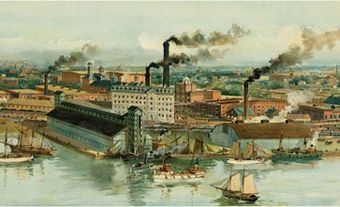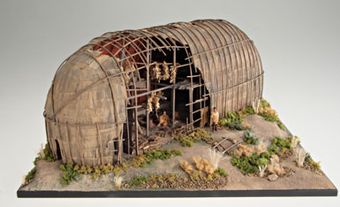Mediterranean Archaeology
For decades, numerous Canadian scholars have made important contributions to Greek, Roman and Near Eastern archaeological studies. Since 1969 the SOCIAL SCIENCES AND HUMANITIES RESEARCH COUNCIL OF CANADA (SSHRCC) has authorized full funding of archaeological research programmes. The funding has allowed Canadian academics and their students to carry out research projects of long duration in Italy, Greece, Egypt, Tunisia, Turkey, Syria and Jordan, where they often work in collaboration with the local authorities or with other European or North American universities.Italy
The UNIVERSITY OF ALBERTA has been active in southern Italy for several decades, in the ancient areas of Lucania and Apulia. This work started with the excavation of several indigenous pre-Roman sites, such as Botromagno, Monte Irsi and Roccagloriosa. More recent research concentrated on settlement developments, land use and social transformations during the Roman period at several sites, including San Giovanni di Ruoti and Masseria Ciccotti.
Since 1987, a Canadian-Italian team, Helena Fracchia (University of Alberta) and Maurizio Gualtieri (University of Alberta/University of Perugia), in collaboration with the Archaeological Superintendency of Basilicata, has been conducting a territorial survey in the upper Bradano Valley of eastern Basilicata. Extensive excavation has also been carried out at Masseria Ciccotti near modern-day Oppido Lucano, which is one of the major sites in that watershed. Research in the area has been concentrating on settlement development and land use in the Roman period. The site of Masseria Ciccotti was occupied between the 1st century BC and the 5th century AD. The finds from the site, in particular the figured mosaics of the 3rd century AD, are part of the permanent display at the National Archeological Museum of Muro Lucano.
Since 1990, Fracchia and Gualtieri have also been excavating a long-lived site at Ossaia, near Cortona in the province of Tuscany. This work was carried out in collaboration with the Town of Cortona, the University of Perugia, and the Archaeological Superintendent of Tuscany. The site evolved from an Etruscan rural sanctuary in the 5th through 2nd century BC, into an imperial villa belonging to Gaius and Lucius Caesar in the 1st century BC-AD. In the 2nd century AD the site was transformed into a production centre for tile, brick, amphorae and lamps, before becoming again an opulent residence in the middle of the 3rd century AD. This ongoing research focuses on the settlement change, social transformations and economic basis of the site. The material from this excavation is part of the permanent display at the Museum of the Accademia Etrusca in the City of Cortona.
During a field survey in the Basantello River valley of Apulia by a joint Canadian and British team, a number of Roman imperial period sites were discovered. Alastair Small (University of Alberta/University of Edinburgh) is investigating a Roman rural settlement at Vagnari. The brick stamps indicate that the settlement was part of a large imperial estate and was a production centre for brick and tile during the Roman imperial period. Following intensive surface survey and geophysical prospecting, excavations started in 2005 at a site at San Felice, which is linked to the Vagnari site. This work was conducted under the direction of J. Hans vanderLeest (MOUNT ALLISON UNIVERSITY), with the collaboration of Myles McCallum of the University of Nevada (Reno) and British colleagues. The excavations have revealed a substantial villa complex including a large peristyle dated between the late 1st and early 3rd century AD.
The UNIVERSITY OF BRITISH COLUMBIA is also active in Sicily. Excavations have finished at the hilltop town of Monte Polizzo in western Sicily. These excavations in the native and Punic site of Monte Polizzo have helped to rectify a clear bias favouring the excavation and thus knowledge of colonial Greek and/or Roman sites. This, research focused on Monte Polizzo's cultural development and interaction with neighbouring Phoenicio-Punic, Greek, and native sites. The excavations were part of the Sicilian-Scandinavian Archaeological Project, developed by the Trapani Superintendency and the University of Gothenburg. The project expanded to include teams from other universities in Europe and North America. Stanford University (California) and a team from the University of British Columbia, under the direction of Franco De Angelis, worked together on Monte Polizzo's acropolis. So far, these excavations have resulted in the identification of five phases of activity, from the Bronze Age to modern times.
Greece
The Canadian Archaeological Institute in Athens facilitates scholars working in Greece.
Since 2004, a University of Alberta team directed by Margriet Haagsma and the 15th Ephorate of Prehistoric and Classical Antiquities at Larissa have been collaborating on a survey at Kallithea, which is possibly the town of ancient Peuma in Achaia Phthiotis, Thessaly. The archaeological remains consist of a fortified urban centre on a 600-metre-high hilltop. The fortified acropolis, with a small temple, was constructed in the Late Archaic or Classical periods. The surrounding urban centre, consisting of houses and streets laid out according to a regular grid plan, was constructed in the late 4th or early 3rd centuries BC. The agora and adjacent public buildings formed part of this regular and well-preserved plan, which also included a second small temple. The habitation area was surrounded by a fortification wall, with 49 towers, two major city gates and three postern gates. The finds and their distribution suggest limited use of the site during the 6th and 5th century BC, intensive occupation from the end of the 4th until the later 3rd century BC, and limited occupation again in the 2nd century BC. The Kastro (castle) at Kallithea provides an excellent opportunity to study developments in city planning and housing in Thessaly, and allows researchers to explore in greater detail the dynamics of settlement and abandonment in this region during the Archaic, Classical and Hellenistic periods.
The University of British Columbia has been active in Greece since 1984, when Hector Williams initiated the excavations that continued through 1994 at Mytilene. Archaeologists uncovered a sanctuary of Demeter and Kore, as well as the burial chapel of the Gattelusi family, who ruled the northern Aegean from 1355 to 1462. Rich discoveries of pottery, lamps, figurines, loom weights, animal sacrifices and plant remains from the sanctuary provide an excellent vision of a cult centre of the Classical period.
Since 1994, Williams has also carried out another research project at Stymphalos, a modest Late Classical and Hellenistic city in the mountains of Arcadia. The site has been completely mapped by a pioneering large-scale geoarchaeological survey. The team has recovered remains of the stage building of the theatre, part of a palaestra, several streets and houses including the remains of a massive door with bronze decoration, a sanctuary with a small temple and hundreds of votive offerings of statuary, jewellery, figurines and pottery. Much of the city's defences have also been found, along with at least five substantial Doric buildings (including two with marble roof tiles), and five early Christian cemeteries of the 5th-6th century AD. The Middle Palaeolithic to Late Bronze Age periods are also documented at the site. After a period of abandonment, the site was probably resettled in the early imperial period, perhaps by Roman veterans whose weaponry was found in a villa destroyed by earthquake circa 40 AD. The site has also been the object of various types of geophysical exploration; the results have provided a good picture of the buried town.
Since 1976, the UNIVERSITY OF TORONTO has received large-scale funding to carry out excavations at the Cretan site of Kommos, under the direction of Maria and Joseph Shaw. One of Canada's largest archaeological projects overseas, Kommos has provided opportunities for an international team of specialists to examine in great detail the life, architecture, and environs of a small but apparently important village (archaeologists estimate the population at 300 to 400 people) in the second millennium BC. An unexpected discovery was a remarkable sanctuary built over the southern part of the site that seems to have been used from later sub-Minoan times into the early Roman empire.
The UNIVERSITÉ DE MONTRÉAL, under the direction of Jacques Perrault and in collaboration with the Greek Archaeological Service, has been working at the site of Argilos, a Greek colony founded by settlers from the island of Andros circa 650 BC. The city was a prosperous centre from the 6th to 3rd centuries BC. Well-preserved city remains of houses, cobbled streets and a wealth of pottery document the urban development of a Greek city over three centuries.
Tunisia
The city of Leptiminus (Lamta) in Tunisia flourished from Punic times to the Byzantine Period (circa 500 BC to 700 AD). Little standing architecture survives, but the remains of an amphitheatre and a public bath are visible in the compound of the archaeological museum. In 1995 the UNIVERSITY OF MANITOBA joined an international field survey and excavation at the site under the direction of Dr Nejib Ben Lazreg. The Canadian team, led by Lea Stirling, has focused on a complex of kiln potting workshops in use during the 1st to 3rd centuries AD, and a Roman cemetery dating from the 2nd to 4th centuries AD.
Syria
After excavating the early Bronze age (circa 2800-2400 BC) sites of Tell 'Atij and Tell Gudeda between 1986 and 1993, Michel Fortin from UNIVERSITÉ LAVAL started another project in Syria. The Canadian team, led by Dr Fortin and Elizabeth Cooper (University of British Columbia), investigated Tell 'Acharneh between 1998 and 2004. Tell 'Acharneh is a large site that covers an area of 70 ha; it is located about 35 kilometres northwest of the modern city of Hama. Tell 'Acharneh was occupied during the Bronze and Iron ages (ie, from 2500 to 700 BC) and could possibly be the site of the ancient city of Tunip. The site also contains a medieval fortification dated to the end of the 11th century, that is, around the time of the First Crusade. In 2004, a Syro-Canadian team conducted a geoarchaeological survey in the Ghab Valley, where Tell 'Acharneh is located. About 40 archaeological sites have been discovered so far.
Jordan
Since 1991, John P. Oleson from the Department of Greek and Roman Studies at the UNIVERSITY OF VICTORIA has been directing surveys and excavations at Humayma (formerly "Humeima"), the site of ancient Hawar in Jordan's southern Hisma Desert. This small trading post and caravan stop was founded by the Nabataean King Aretas III circa 80 BC, to serve as a centre for sedentarization of the local nomadic Nabataean pastoralists. After the Roman conquest in the 1st century AD and a short period of prosperity during the Byzantine and early Islamic periods, the site was abandoned around 750 AD. The main goal of the excavation project is to reconstruct the circumstances of Humayma's foundation, growth and decline, and to understand the reasons for its Roman military occupation. The project will shed some light on the character of "Roman" culture at the site and the interactions between the Romans and the small indigenous desert population.

 Share on Facebook
Share on Facebook Share on X
Share on X Share by Email
Share by Email Share on Google Classroom
Share on Google Classroom


